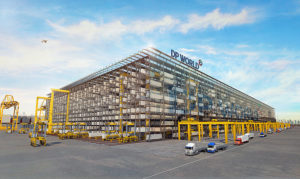 The Dubai-based global port operator has announced a disruptive technology that would radically improve operations, efficiency and capacity at container terminals. The world’s first multi-storey container stacking system is suggested by the joint-venture formed by DP World and SMS group, a German family-owned industrial engineering company. The new technology will be first implemented at DP World’s flagship Jebel Ali Terminal 4, in time for the 2020 World Expo fair in Dubai.
The Dubai-based global port operator has announced a disruptive technology that would radically improve operations, efficiency and capacity at container terminals. The world’s first multi-storey container stacking system is suggested by the joint-venture formed by DP World and SMS group, a German family-owned industrial engineering company. The new technology will be first implemented at DP World’s flagship Jebel Ali Terminal 4, in time for the 2020 World Expo fair in Dubai.
The High Bay Storage system was originally developed by SMS group subsidiary AMOVA for round the clock handling of metal coils that weigh as much as 50 tons each in racks as high as 50m. AMOVA is the first company to transfer this proven technology from the metallurgical sector to the port industry.
Instead of stacking containers directly on top of each other, which has been global standard practice for decades, the system places each container in an individual rack compartment. Containers are stored in an eleven-storey rack, creating 200% more capacity than a conventional container terminal, or creating the same capacity in less than a third of the space.
Thanks to the rack’s design, each container can be accessed without having to move another one, enabling 100% utilization in a terminal yard. The system brings big gains in speed, energy efficiency, better safety and a major reduction in costs.
Costs are further cut by the ability to shorten the time taken to load and unload mega-ships by as much as 30%.
Sultan Ahmed Bin Sulayem, DP World Group Chairman and CEO, said: “DP World’s experience and expertise in moving cargo coupled with the technology of AMOVA will ensure the system is remarkably efficient and relevant for present and future operations. As a world first in our industry we are tremendously excited by its potential and groundbreaking features.”
Dr. Mathias Dobner, CEO of the joint venture, said: “This new container handling technology allows cities to use their expensive and sensitive land and waterfront areas more effectively. Our system will significantly increase the productivity of handling ships on the quay. This disruptive innovation will greatly improve the financial performance of container ports, as well as their overall appearance.”
DP World does not disclose further details of how containers would be physically moved from the quay and placed in the stacks. It remains to be seen what machinery will be used at these innovative facilities, as obviously it looks like regular RTGs might become a legacy type of equipment.
There is evidence that similar multi-storey stacking systems are also being developed by other terminal operators, especially in locations with lack of space. According to Splash24, PSA intends to incorporate a similar container storing method at its new Tuas megaport in Singapore.
